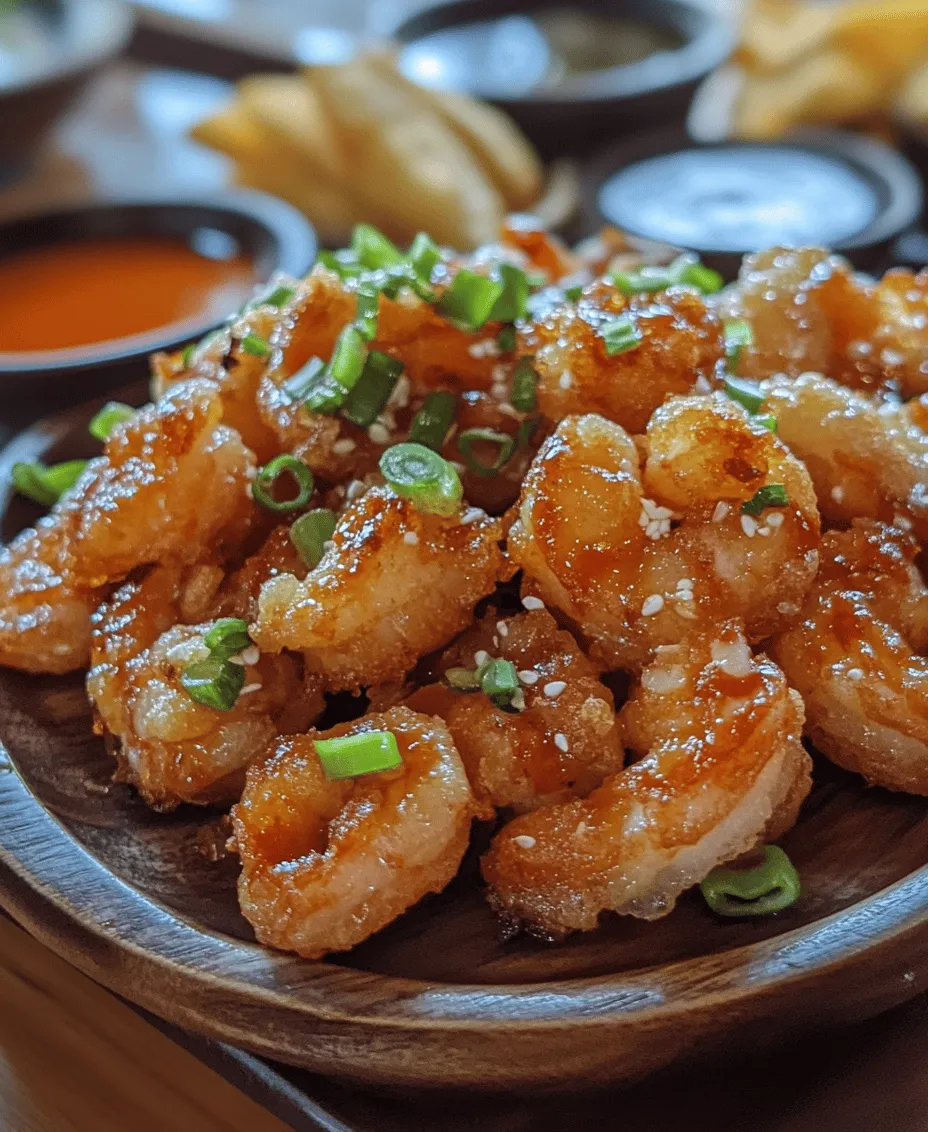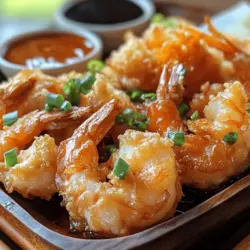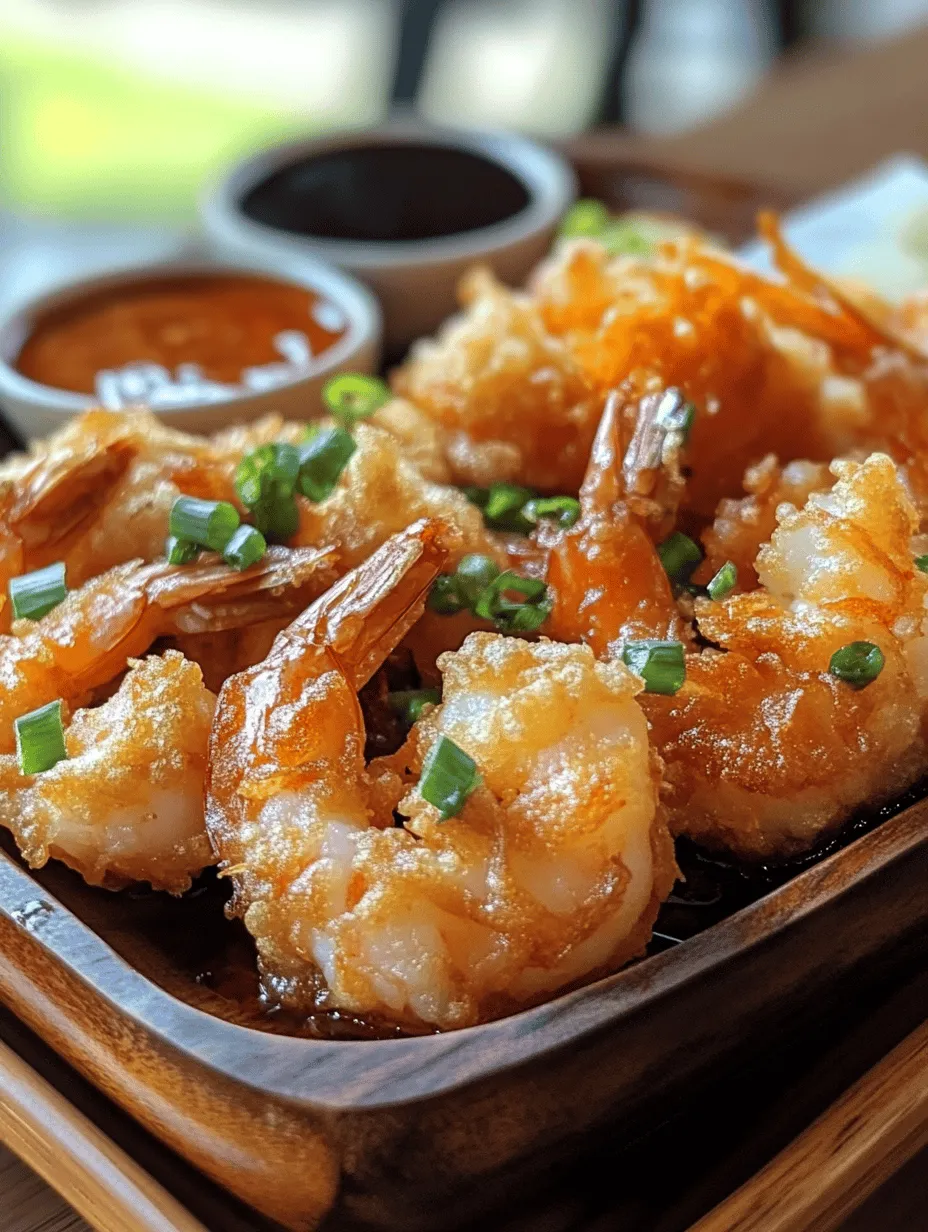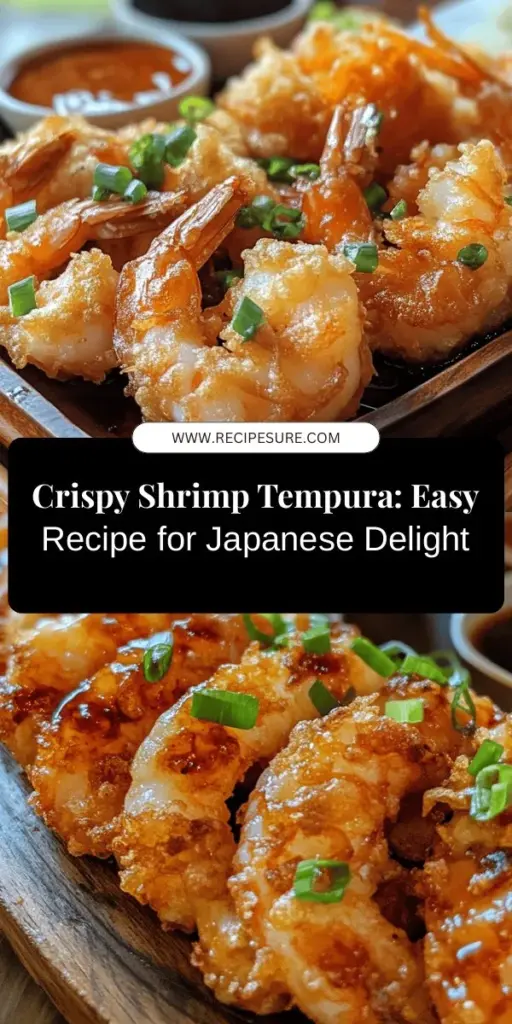Introduction
Shrimp tempura is a beloved dish that has won the hearts of food enthusiasts around the globe. Rooted in Japanese culinary tradition, it features succulent shrimp encased in a delicate, crispy batter that tantalizes the taste buds. The contrast between the light, airy coating and the tender shrimp creates an irresistible texture that everyone loves. Not only is shrimp tempura a staple in sushi bars and restaurants, but it’s also a versatile dish perfect for home cooking, allowing chefs of all skill levels to experience the joy of creating authentic Japanese flavors in their kitchens.
The appeal of shrimp tempura extends beyond its taste; it also brings a sense of celebration to any meal. Whether served as an appetizer, a main course, or as part of a multi-course Japanese feast, shrimp tempura can elevate your dining experience. Its versatility allows it to pair beautifully with various dipping sauces, salads, or even alongside rice and vegetables. With its crispy exterior and succulent interior, shrimp tempura stands out as a dish that is not only delicious but also visually appealing, making it an ideal choice for gatherings and special occasions.
Understanding Shrimp Tempura
Tempura is a cooking technique that has been embraced and refined within Japanese cuisine, and it has its origins dating back to the 16th century. While the exact history is somewhat debated, it is widely believed that the practice of frying food in batter was influenced by Portuguese missionaries and traders who introduced their cooking methods to Japan. Over the years, tempura evolved into a distinctly Japanese culinary art, celebrated for its lightness and crispiness.
Shrimp tempura, in particular, has gained immense popularity not just in Japan but around the world. It is a staple on Japanese menus and is often enjoyed by those seeking a delightful seafood experience. The key characteristics that define a perfect shrimp tempura include its light, airy batter that envelops the shrimp, a golden-brown color, and an audible crunch when bitten into. The flavor should be a harmonious blend of the natural sweetness of the shrimp and the subtle seasoning of the batter, creating a satisfying experience for the palate.
Ingredients Breakdown
To prepare crispy shrimp tempura, you need a few essential ingredients that work together to create the perfect dish. Here’s a detailed breakdown of each ingredient used in the recipe:
Large Shrimp
The star of the show is, of course, the shrimp. When selecting shrimp for tempura, freshness is paramount. Opt for large shrimp, preferably wild-caught if possible, as they offer a firmer texture and a more robust flavor compared to farmed varieties. The size of the shrimp is also important, as larger shrimp can stand up to the frying process without becoming overcooked. Look for shrimp that have a slight sheen and a fresh, briny smell to ensure optimal quality.
All-Purpose Flour
All-purpose flour is the primary component of the tempura batter, providing the necessary structure. It is essential to use high-quality flour to achieve a crispy coating. The flour should be sifted before use to eliminate any lumps, which can affect the texture of the batter. This ingredient is responsible for the lightness of the batter, as it binds the other ingredients together while allowing the moisture to escape during frying.
Cornstarch
Cornstarch plays a crucial role in achieving the crispy texture of the tempura batter. When combined with all-purpose flour, cornstarch helps create a lighter, crunchier coating that enhances the overall eating experience. It has a unique ability to absorb moisture, which is key to achieving that coveted crispiness. Using the right ratio of cornstarch to flour can significantly impact the final result, making it an essential ingredient in this recipe.
Baking Powder
Baking powder is an ingredient that contributes to the light and airy texture of the tempura batter. It releases carbon dioxide bubbles during frying, which helps the batter puff up and become crispy. This ingredient is particularly important for ensuring that the shrimp tempura does not turn out dense or heavy. Using baking powder in moderation will provide the perfect lift to your batter.
Sesame Oil
While not a mandatory ingredient, adding a bit of sesame oil to the batter enhances the overall flavor of the shrimp tempura. It adds a subtle nuttiness and depth that can elevate your dish. Sesame oil has a high smoke point, making it suitable for frying, and it brings a unique aroma that complements the shrimp beautifully. A small amount goes a long way, so be careful not to overpower the dish with its strong flavor.
Vegetable Oil
Choosing the right oil for frying is essential in achieving perfectly crispy shrimp tempura. Vegetable oil is often recommended due to its neutral flavor and high smoke point, making it ideal for deep frying. Oils such as canola, sunflower, or peanut oil are excellent choices, as they can withstand the high temperatures required for frying without imparting any unwanted flavors. Maintaining the right frying temperature is crucial, as it helps to ensure the batter cooks evenly and becomes crispy without absorbing excess oil.
Optional Ingredients
While the core ingredients are essential for making shrimp tempura, you may also consider incorporating optional ingredients such as dipping sauces and garnishes. Traditional dipping sauces like tentsuyu, made from dashi, soy sauce, and mirin, can enhance the flavor experience. Additionally, garnishes such as grated daikon radish or finely chopped green onions can add a fresh touch to the presentation.
Preparation Steps for Perfect Shrimp Tempura
Creating the perfect shrimp tempura involves careful preparation and attention to detail. Here are the essential steps to ensure your dish turns out deliciously crispy and light:
Preparing the Shrimp
The first step in preparing shrimp tempura is ensuring that your shrimp are cleaned and prepped correctly. Rinse the shrimp under cold water to remove any residual grit or impurities. After rinsing, pat them dry thoroughly with paper towels. This step is crucial as excess moisture can lead to soggy batter and less crispy results.
Next, you will want to score the shrimp. This technique involves making shallow cuts along the underside of the shrimp, which helps prevent curling during frying. Use a sharp knife to make two or three diagonal slits, being careful not to cut all the way through. This simple step will ensure that your shrimp lay flat while cooking, allowing for even frying.
Crafting the Tempura Batter
Once your shrimp are prepped, it’s time to prepare the tempura batter. In a mixing bowl, combine the all-purpose flour, cornstarch, and baking powder. The key to achieving the right batter consistency is to mix these dry ingredients gently. Overmixing can lead to gluten development, which will make the batter heavy rather than light and crispy.
Next, add ice-cold water or sparkling water to the dry ingredients. The temperature of the water is crucial; cold water helps create steam during frying, which contributes to the lightness of the batter. If using sparkling water, the carbonation can add additional airiness to the batter. Stir the mixture lightly until just combined; it’s okay if there are some lumps, as this will help create that desired texture.
Common Mistakes to Avoid
While making shrimp tempura may seem straightforward, there are common mistakes to watch out for that can affect the final result. Avoid overmixing the batter, as this can lead to a dense coating. Remember, the less you mix, the lighter and crispier the batter will be. Another mistake is not maintaining the right frying temperature; if the oil is too cool, the batter will absorb excess oil and become greasy, while too hot oil can burn the batter before the shrimp are cooked through. Aim for a frying temperature of around 350°F (175°C) for the best results.
By following these preparation steps, you will be well on your way to creating mouthwatering crispy shrimp tempura that will impress your family and friends. The combination of fresh shrimp and a perfectly crafted batter makes for a dish that is not only delicious but also a celebration of Japanese culinary traditions.
Stay tuned for the next part of this article, where we will dive into the frying process, serving suggestions, and tips for perfecting your shrimp tempura experience!

Heating the Oil: Best Practices for Ensuring the Correct Frying Temperature and Oil Quantity
When it comes to frying shrimp tempura, achieving the perfect oil temperature is crucial for that coveted crispy texture. The ideal frying temperature for tempura is between 350°F to 375°F (175°C to 190°C). If the oil is too hot, the batter will burn before the shrimp cooks through; if it’s not hot enough, the batter will become greasy and soggy.
Best Practices for Heating Oil:
1. Choose the Right Oil: Use oils with high smoke points, such as vegetable oil, canola oil, or peanut oil. These oils can withstand high temperatures without breaking down.
2. Quantity of Oil: A deep pot or a wok is ideal for frying tempura. You’ll need about 2-3 inches of oil to allow the shrimp to float freely, which helps achieve even cooking.
3. Thermometer Use: A candy or deep-fry thermometer is essential for monitoring the oil temperature accurately. This tool will help maintain the ideal frying range.
4. Preheating: Gradually heat the oil over medium heat, avoiding high flames that can cause the oil to heat unevenly. Allow the oil to reach the desired temperature before adding the shrimp.
Frying Techniques for Optimal Crispiness
Now that your oil is heated to perfection, it’s time to fry the shrimp tempura. Follow these steps to ensure an ideal outcome.
Step-by-Step Guide to Frying Shrimp Tempura:
1. Prepare Your Frying Station: Set up a plate lined with paper towels to drain the excess oil. Have your batter-coated shrimp ready to go nearby.
2. Batch Frying: To maintain the oil temperature, fry the shrimp in small batches—about 4-5 pieces at a time. This prevents overcrowding, which can lower the oil temperature and result in soggy tempura.
3. Frying Process: Carefully lower the batter-dipped shrimp into the hot oil using tongs or a slotted spoon. Avoid dropping them in from a height, which can cause splattering.
4. Cooking Time: Fry the shrimp for about 2-3 minutes, turning them gently halfway through the cooking process to ensure even browning.
5. Visual Cues for Doneness: The shrimp should turn a golden brown color and the batter should appear crispy. The shrimp will also curl slightly, which is an indication they are cooked through.
6. Draining Excess Oil: Once fried, remove the shrimp with a slotted spoon and place them on the paper towel-lined plate to drain any excess oil.
Tips for Turning Shrimp for Even Cooking Without Damaging the Batter:
- Use a gentle motion when flipping the shrimp to avoid breaking the delicate batter.
- If you notice any batter clinging to the bottom of the fryer, gently lift it off with tongs to avoid it burning and affecting the oil quality.
Presentation and Serving Suggestions
Once your shrimp tempura is perfectly fried and drained, it’s time to present this beautiful dish.
How to Effectively Drain Excess Oil to Maintain Crispiness:
- Place the shrimp tempura on a cooling rack set over a baking sheet instead of directly on paper towels. This allows air to circulate around the shrimp, keeping them crispy.
Ideas for Garnishing the Finished Dish:
- Garnish your plated shrimp tempura with finely sliced green onions or shiso leaves for a pop of color and added flavor. A sprinkle of sesame seeds can also enhance the visual appeal.
Discussion of Popular Dipping Sauces and Their Flavor Profiles:
- Tempura is traditionally served with a light dipping sauce known as tentsuyu, made from dashi, soy sauce, and mirin. This sauce complements the delicate flavor of the shrimp without overpowering it.
- Other popular sauces include a spicy mayo or ponzu sauce, which adds a citrusy tang to the dish.
Suggestions for Complementary Side Dishes or Beverages:
- Serve your shrimp tempura alongside a refreshing salad, such as a cucumber salad, to balance the richness of the fried shrimp.
- A light miso soup can also be a comforting addition to your meal. For beverages, consider pairing with a glass of chilled sake or a crisp white wine to enhance the overall dining experience.
Nutritional Information
Shrimp tempura, while undeniably delicious, is also a dish to enjoy in moderation.
Overview of the Nutritional Aspects of Shrimp Tempura:
- A serving of shrimp tempura provides a good source of protein, primarily from the shrimp itself. Shrimp is low in calories and high in nutrients, making it a healthy choice when consumed in moderation.
Protein Content from Shrimp:
- A 3-ounce serving of shrimp contains approximately 20 grams of protein, which is essential for muscle repair and overall health. Additionally, shrimp is an excellent source of selenium and vitamin B12.
Discussion on the Balance of Indulgence and Moderation in Enjoying Fried Foods:
- While shrimp tempura is a delightful treat, it is fried and should be enjoyed occasionally. Balancing it with fresh vegetables and lighter dishes can help maintain a healthy diet while still indulging in your favorite flavors.
Cultural Significance and Variations
Shrimp tempura is more than just a dish; it has a rich cultural significance within Japanese cuisine.
Insight into How Shrimp Tempura Fits Into Japanese Meals and Dining Etiquette:
- In Japan, tempura is often served as part of a larger meal, typically with rice and miso soup. The dining experience emphasizes balance and harmony, with tempura providing a crispy contrast to softer foods.
Variations of Tempura Beyond Shrimp:
- Tempura is not limited to shrimp. Other popular ingredients include seasonal vegetables like sweet potatoes, zucchini, and bell peppers. In some regions, even fish is used, showcasing the versatility of this cooking technique.
Modern Interpretations and Fusion Recipes that Incorporate Tempura:
- Chefs around the world are experimenting with tempura, creating fusion dishes that incorporate different flavors and ingredients. For example, tempura tacos or tempura sushi rolls highlight the adaptability of this classic dish.
Conclusion
Making crispy shrimp tempura at home is not just a cooking process; it’s an experience filled with joy and satisfaction. From the careful preparation of the batter to the careful frying technique that results in that perfect crunch, each step offers an opportunity to connect with the art of cooking.
As you explore the various variations and dipping sauces, don’t hesitate to put your unique spin on this traditional dish. Whether you enjoy it as a standalone treat or as part of a larger meal, shrimp tempura is sure to impress both family and friends.
In the end, the experience of cooking and sharing shrimp tempura brings people together, creating lasting memories around the table. So gather your ingredients, invite loved ones, and indulge in the delightful world of homemade shrimp tempura.


